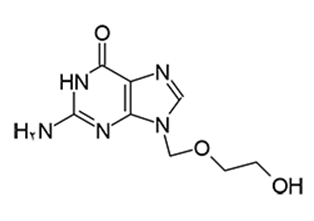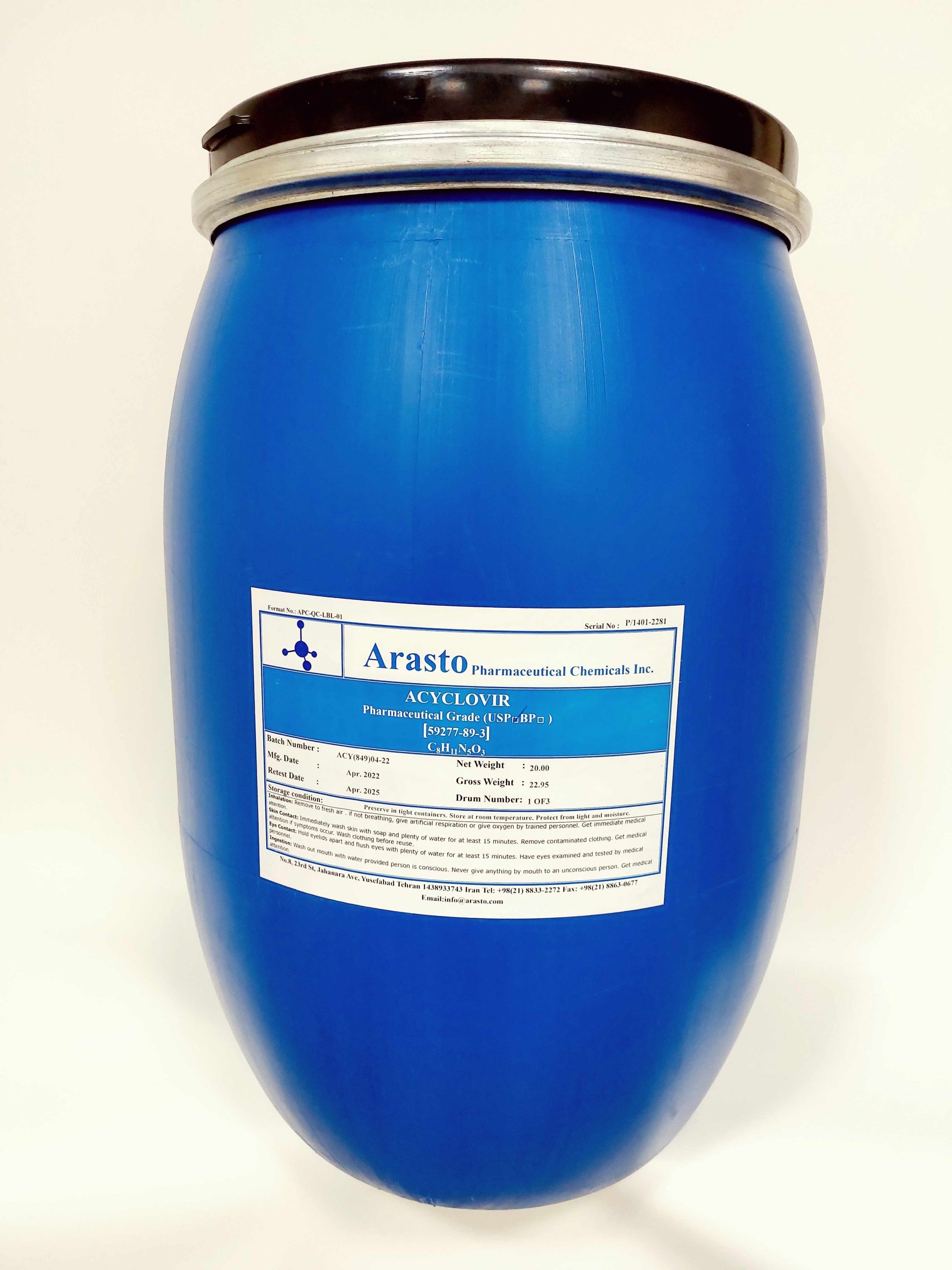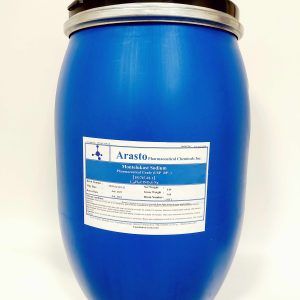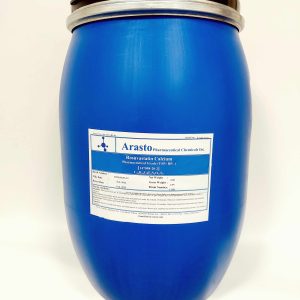Description
Description
(BP2022/USP 44)
- Drug Substance General Information (ICH 3.2.S.1)
1.1. Nomenclature (ICH 3.2.S.1.1)
International non-proprietary name: Acyclovir (Brand Name: Zovirax, Acicloftal, Poviral, Virorax, Vargocil)
Compendial name: Acyclovir
Chemical name: 6H-Purin-6-one, 2-amino-1, 9-dihydro-9-[(2-hydroxyethoxy) methyl]-.
9-[(2-Hydroxyethoxy) methyl] guanine
Arasto’s code: ACY
CAS Registry Number: [59277-89-3]
1. Drug Substance General Information (ICH 3.2.S.1)
1.2. Structure (ICH 3.2.S.1.2)

Empirical formula: C8H11N5O3
Molecular Weight: 225.20 g/mol
- Drug Substance General Information (ICH 3.2.S.1 )
1.3. General Properties (ICH 3.2.S.1.3)
Acyclovir is a white crystalline substance. It is an orally administered agent used for the treatment for the treatment Herpes Zoster infections, genital herpes and chickenpox. Acyclovir is insoluble in water and most organic solvents, very slightly soluble in alcohol and somewhat soluble in DMSO. It is soluble in water at alkaline pH due to salt formation (pKa= 9.3, for ionization of the guanine OH and pKb=2.3 for protonation of guanine nitrogen, (see C. Hansch, et al, Comprehensive Medicinal Chemistry, Vol.6, New York, Pergamon Press 1990). Its log P has been reported to be -1.59 (http://www.ncbi.nlm.nih.gov/pmc/articles/PMC2167972/).Acyclovir is relatively inert to acid and base (see Stability Studies). LD50 of Acyclovir has been reported (mice > 10,000 mg/kg oral; 1000 mg/kg ip, see the Merck Index, 12th Edition, 1996).
The determination of purity and assay of APIs require comparison of the product with their respective Reference Standards (RS) and Related Compounds (RC or known impurities). Accordingly, ICH regulations on the purity and assay of reference standard and related compounds are clearly defined and must be followed by drug substance and drug product manufacturers.
According to ICH Q7, 11.1 there are 3 types of standards. This is summarized in the following chart and discussed in detail below.

The impurities provided in the following table represent Secondary Reference Standards (SRS) that are prepared in-house by synthesis or by isolation. Each SRS has undergone extensive characterization ( IR, UV, 1HNMR, 13CNMR. Mass Spec) and determination of its purity and assay (HPLC). For specification of the SRS of those products that have a monograph, the SRS is compared with a pharmacopoeia Primary Reference Standard (UV, HPLC retention time). For specification of those products that do not have a monograph (known as House Primary Standard), we compare their UV ε or ג /max , IR major absorptions, 1HNMR d (ppm) , 13 CNMR d (ppm) or HPLC retention time with values reported in the chemical literature for these compounds.

- Primary and Secondary Reference Standard (ICH 3.2.S.5)
5.1. Active Pharmaceutical Ingredient
Primary Reference Standard for acyclovir is available from United States Pharmacopoeia. We will use a Secondary Reference Standard (previously referred to as Working Standard) for direct control of all batches of acyclovir.
As per ICH (Q7, 11.1) and ICH (Q6, 2.11, 3.2, 3.3) the Secondary Reference Standards, which include the API and its Related Compounds, must be examined for their proof of structure (characterization), assay and purity and specification (identification by comparison). Furthermore, ICH Guideline on the Preparation of Common Technical Document (Q4M) requires that the data obtained from characterization, assay and purity and specification must be included in section 3.2.S.3.2 for Related Compounds (already discussed in that section) and section 3.2.S.5 of the DMF for the API. To this end, the Secondary Reference Standards of the API acyclovir has undergone extensive characterization (UV, IR, 1 H NMR, 13C NMR, and Mass Spec) to assure its structure, assay and purity (HPLC and/or titration) and specification (comparison of its HPLC retention time and UV ג /max with USP Primary Reference Standard.
The Secondary Reference Standard for acyclovir was produced from a released batch of acyclovir by subjecting it to an additional crystallization from the final solvent system used in the production of the API to avoid the possibility of other polymorph formation.
SPECIFICATION OF ANALYSIS
| Product: Acyclovir | CAS No.: 59277-89-3 | Spec. No.: APC-QC-SPEC-362-00 | ||
| Issue Date: Apr, 2023 | Valid up to: Apr, 2024 | Reference: BP2022 | ||
| Tests | Specifications | |||
| Appearance | White or almost white, crystalline powder. | |||
| Solubility | Slightly soluble in water, very slightly soluble in ethanol (96%), practically insoluble in heptane. It dissolves in dilute solutions of mineral acids and alkali hydroxides. | |||
| Identification | Infrared absorption spectrophotometry | |||
| Appearance of solution | The solution is clear and not more intensely coloured than reference solution Y7. | |||
| Water | Max. 6.0% | |||
| Residual Solvents | Methanol: Max. 3000 ppm (Class II) | |||
| Sulphated Ash | Max. 0.1% | |||
| Appearance | White or almost white, crystalline powder. | |||
| Solubility | Slightly soluble in water, very slightly soluble in ethanol (96%), practically insoluble in heptane. It dissolves in dilute solutions of mineral acids and alkali hydroxides. | |||
| Related substances (HPLC) | Impurity A: Max. 0.2% Impurity B: Max. 0.7% Impurity C: Max. 0.1% Impurity F: Max. 0.1% Impurity G: Max. 0.2% Impurity I: Max. 0.1% Impurity J: Max. 0.2% Sum of impurities K & R: Max. 0.2% Impurity N: Max. 0.2% Sum of impurities O & Q: Max. 0.3% Impurity P: Max. 0.2% Unspecified impurities: Max. 0.05% Total: Max. 1.5% | |||
| Assay (Titration) | 98.5% to 101.0% (anhydrous substance) | |||
| Prepared by: M. Shahbazi, B.Sc.Chem. | Checked by: A. Forghani, B.Sc.Chem. | |||
| Approved by: F. Javadizadeh, M.Sc.Chem. | ||||
| Storage: Keep in well-closed container and store at a temperature not exceeding 25°C. | ||||





